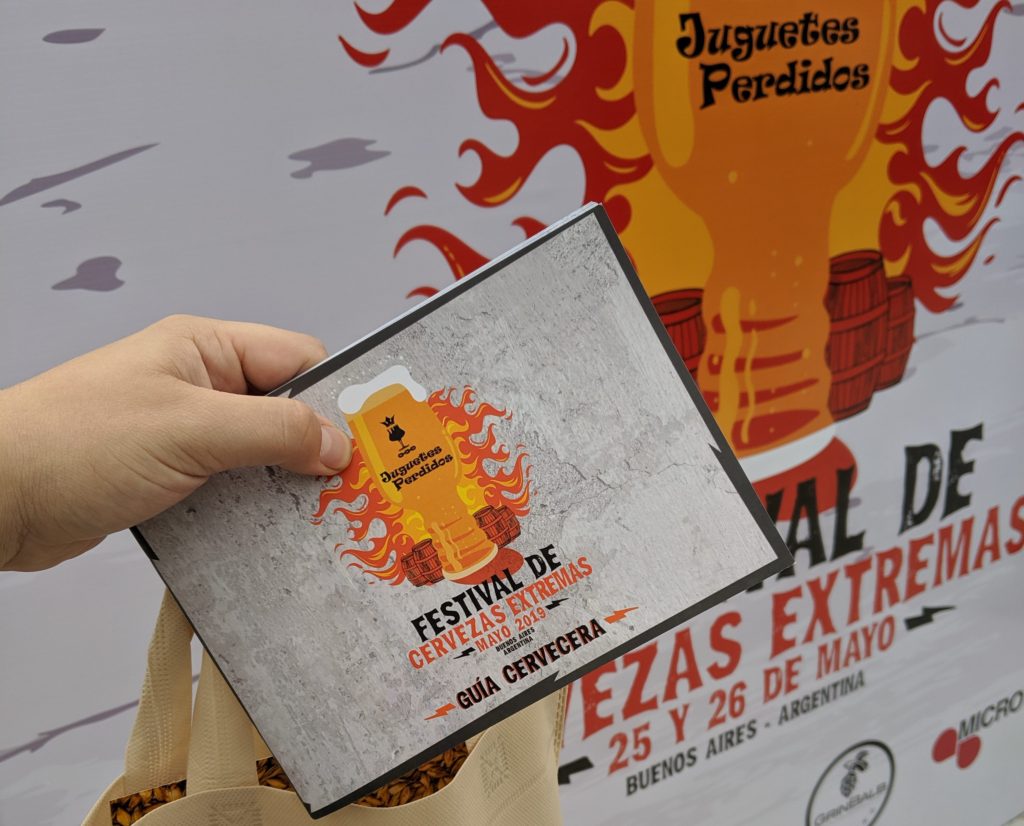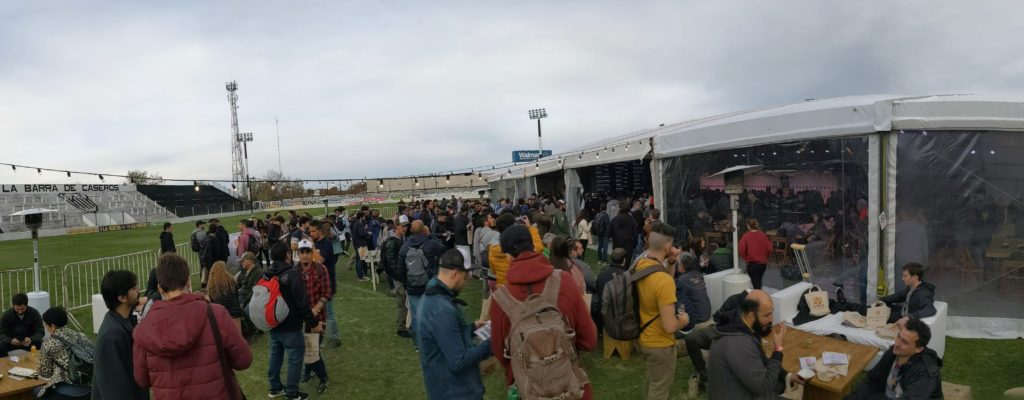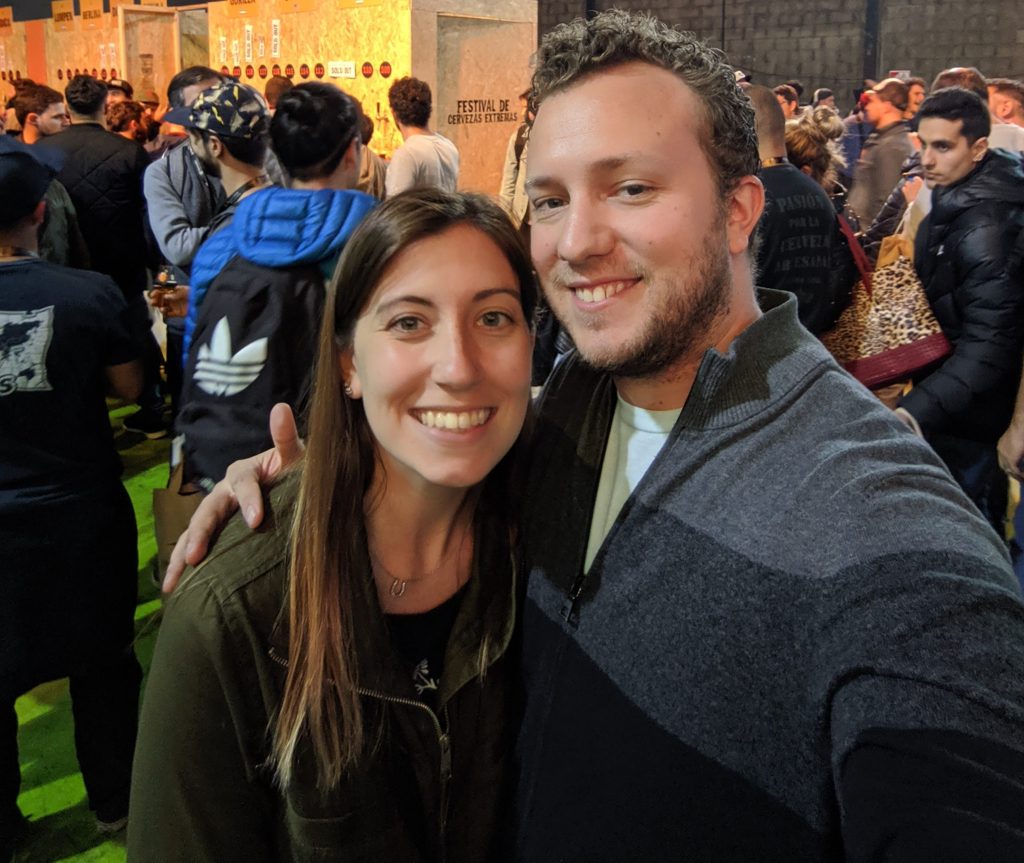Anyone who knows me or Justin knows that Justin loves craft beer. We’ve planned days on trips, detours on trips, and even entire trips around getting beer. We’ve waited in the rain to get beer and chased down elusive Heady Topper through the stores of Burlington, Vermont. I can’t tell you how many beer podcasts I’ve overheard on road trips. He is an avid homebrewer (when we’re not living in Argentina) and has even won awards in a national competition for his beer.
So imagine our excitement, a few weeks after arriving in Buenos Aires, when we found out about the Festival de Cervezas Extremas. We bought tickets right away for the first of the two days of the beer festival, Saturday, May 25. Last week, that day finally arrived! After some slight worries about how we were going to get there because of an impending public transportation strike—which occasionally happens here—we took an Uber to Caseros, the town right outside the city limits of Buenos Aires where the festival was held.
There were more than 200 beers from around the world, including many from South America and some from the U.S., too. The focus of the festival was extreme beer, which Justin tells me is a beer that pushes the limits of flavor, like sour beers or high-alcohol imperial stouts. Our about $50 (USD) entrance was a little steep, especially by Buenos Aires standards, but it came with 15 tokens for tasting pours that were more than enough to last the whole day.
Since Justin is our resident beer expert, I asked him to fill us in on the beer festival and the beer scene in general here. (Note: Edits were attempted for length, clarity and other shenanigans, but Justin rejected most of them!)
But first, one final thought from me about the beer festival: We definitely disproved the theory that you speak foreign languages better when you’ve been drinking!

Colleen: How would you describe the beer festival overall?
Justin: Hey Colleen, first, thanks for having me on, I’ve been a big fan of your work for a while now!
Upon arriving at the location of the festival on the outskirts of the city, my first thought was: “This seems about right.” We all know the number one rule of finding a craft brewery in the U.S. is that if it seems like you are in the wrong place, you are definitely in the right place. As we stood in a line that stretched for a couple blocks and around the corner, I thought, “This, too, feels right.” Hundreds of people eagerly waiting (for sometimes hours on end) to sip unique and rare beers is something that, until the last two decades, would have made even the most dedicated beer enthusiast chuckle.
Why do people do this? Beer has become more than just beer. Whether it is the resurgence of centuries-old techniques that have brought about a new longing for forgotten styles (spontaneously fermented and sour beers), the culinary experimentation (pastry stouts and adjunct heavy beers) and even new fermentation practices that have led to innovative and even more approachable beers (the New England IPA), beer has truly transcended from the common tasteless commodity of days past to an experiential artistic medium.
The fever for great beer, and the sense of community that comes along with it, is certainly present here in Argentina. This was very evident in the sheer amount of beer nerds in line for the festival before the doors were even open!
C: How was the beer festival different or similar the ones you’ve been to in the U.S.?
J: Once we got inside, the format and layout were pretty similar to any U.S. beer festival that I’ve attended: various rows of stations with people pouring small tasters to eager patrons, and each area marked on a map with the brewery name plastered above the tap handles. This particular venue was broken into two disparate sections—one on the soccer field and one in the gymnasium of the town sports complex it was held at.

The real stand-out difference at this festival was the amount of personal interaction all of the patrons were able to have with the brewers! According to the organizers, this was the first festival of extreme beers in Latin America, and all the local breweries showed a great sense of pride and excitement, an attitude that spread to the global brewers there too. Maybe this is part of Argentinian culture, but no one was in a rush to get people through the beer lines. Patrons would talk to the brewers, taste some beer, take photos and just genuinely interact. I met some of my favorite U.S. brewers, and made friends with several local brewers whose brewery doesn’t have regular visiting hours for the public, but they invited us to come check it out “whenever.” I’m not saying this doesn’t happen in the U.S., but between the intimacy of the venue and the overall excitement of the celebration being the first of its kind, there was definitely a jovial sense of camaraderie in the air.
C: What beers or breweries stuck out to you?
J: One of my goals going to the beer festival was to seek out as many local breweries as we could, so we would have a better sense of the beer scene near us. We met and tasted some awesome, new Buenos Aires-based beers like Dos Dingos’ Midnight Oil, a black NEIPA that was a head-scratcher when it came to appearance (dark) versus flavor (complex citrus-forward) in the most awesome way! We had some great offerings from Juguetes Perdidos (the festival’s organizer and host), as well as Grunge Brewing Co., Prinston and Strange Brewing (still my favorite brewery here so far!), all from Buenos Aires. We tried different beers from all over Latin America, from Chile to Costa Rica, and really didn’t have any bad beer.

This event was truly global. In addition to all of the Latin American breweries, some of the most coveted breweries from the U.S. and Europe were in attendance, such as The Rare Barrel, KCBC and Mikkeller Baghaven.
C: How would you describe the beer scene here that you’ve seen so far?
J: All in all, I think the festival was a great representation of where the beer scene down here is heading. New breweries are embracing the collaborative culture and direct-to-consumer business practices that have been the catalysts for the craft beer revolution around the world.
In all honesty, when we first arrived in Buenos Aires, we were hit with tons of restaurants and pubs that advertised “cerveza artesanal.” However, these beers were just labeled by the beer type, with no indication of the brewery. I have gathered that most of these types of places are just contracting out a larger scale brewery to either brew “house” beers, or in other cases are just pushing beers from the Patagonia brewery, which is owned by the evil empire conglomerate AB InBev.
Things were looking grim… until we found Strange Brewing.

Strange was the first brewery we went to in Buenos Aires where you could see the actual brewery, with your own eyes, from the taproom. And the beer and food are exceptional! It is the quintessential taproom experience: hang out for hours with friends while you eat great food and explore the ever-rotating beer list.
Once we found Strange and Bodega Cervezas, a great bottle shop in the Palermo neighborhood, the doors opened to the budding beer culture here for us.
In closing, beer has given us a reason to explore places and meet people we might never have gotten to know otherwise, and those experiences are what craft beer is all about. So we will continue exploring and enjoying and see where this journey takes us next.
